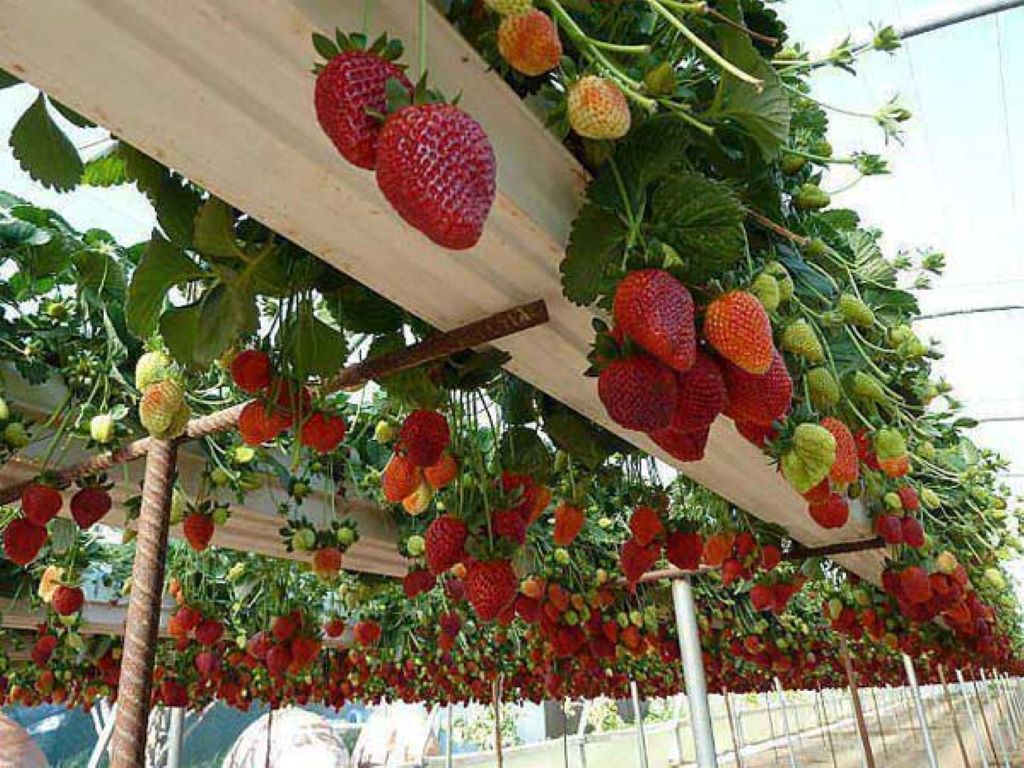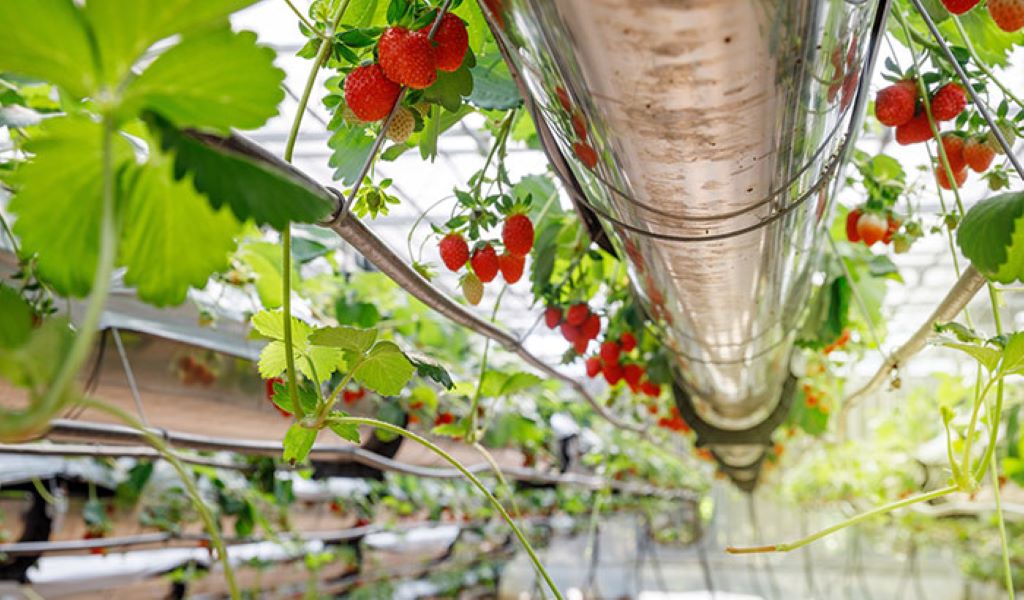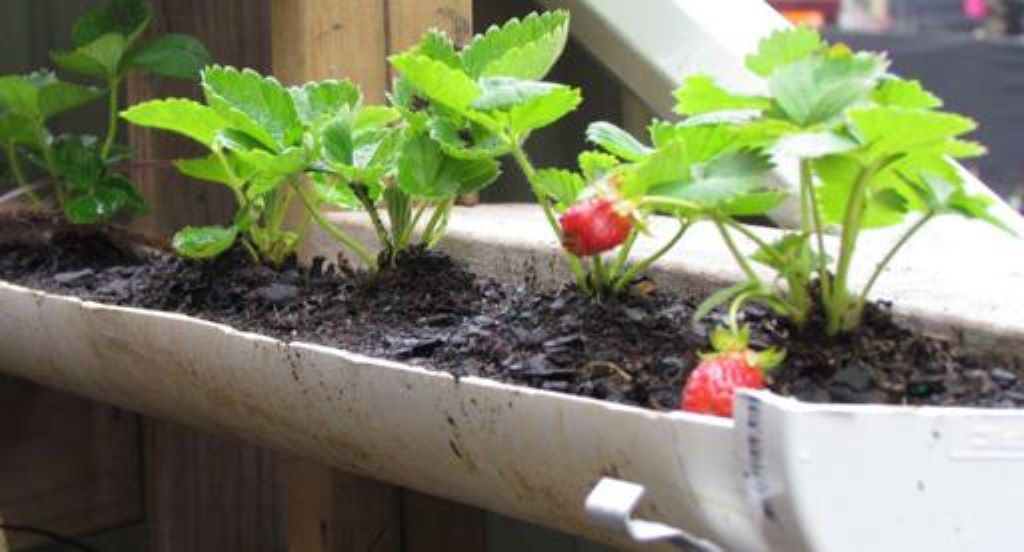
06 Feb Growing Strawberries in Gutters: The Ultimate Guide for Abundant Harvests
Growing strawberries in gutters is a great way to utilize vertical space and maximize your strawberry yield. With proper care and maintenance, you can enjoy a bountiful harvest of juicy strawberries right from your gutter garden.
Choosing The Right Gutter System
When it comes to growing strawberries in gutters, choosing the right gutter system is crucial for ensuring successful growth and yield. Understanding gutter options, including sizing and material considerations, will help you make an informed decision and create an ideal environment for your strawberry plants. In this section, we will explore the different gutter options available and provide you with the necessary insights to select the perfect gutter system for your strawberry gardening project.

Understanding Gutter Options
Gutters come in various shapes, styles, and materials. Before you make a purchase, it’s important to understand the different gutter options available:
- Traditional Gutters: Traditional gutters, also known as half-round or K-style gutters, are the most common choice for homes. They offer a classic look and are typically made of aluminum or vinyl. However, these gutters may require additional modifications to be suitable for growing strawberries.
- Guttering Systems: Designed specifically for gardening purposes, guttering systems are a fantastic option for growing strawberries in gutters. These systems are made of durable materials, such as PVC or metal, and often come with built-in features like drainage holes and water reservoirs.
- DIY Gutters: If you prefer a more hands-on approach, you can create your gutter system using PVC pipes or repurposed materials. This option allows for customization and flexibility to meet your specific gardening needs.
Sizing And Material Considerations
When choosing a gutter system for your strawberry plants, you should consider two important factors: sizing and material considerations:
Sizing:
Ensure that the gutters you choose are wide enough to accommodate the root systems of your strawberry plants. Ideally, the gutter should have a depth of at least 6 inches, giving the plants ample room to grow and spread their roots.
Material Considerations:
The material of the gutter system is crucial for long-lasting performance and optimum strawberry growth. Some popular materials include:
| Material | Advantages | Disadvantages |
| Aluminum | Durable and lightweight | May require additional modifications |
| Vinyl/PVC | Cost-effective and easy to install | May not withstand extreme weather conditions |
| Metal | Highly durable and rust-resistant | Can be more expensive |
Consider the advantages and disadvantages of each material to determine which one best suits your needs and the climate in your area.
By understanding the different gutter options and considering important factors like sizing and material, you can choose the right gutter system for growing strawberries. This will contribute to the overall success of your strawberry gardening project at Alice’s Wonderland Nursery, ensuring optimal growth and a bountiful harvest. If you’re also interested in strawberry growing in pots, this knowledge can be similarly beneficial. Now that we’ve explored the selection process, let’s move on to the next section and learn about preparing the gutter system for planting your strawberry plants.
Preparing The Gutter For Planting
To prepare the gutter for planting strawberries, start by drilling drainage holes in the gutter. Next, line the gutter with landscape fabric and add a layer of potting soil before planting the strawberries. This method allows for efficient use of space and provides good drainage for healthy strawberry growth.
Before you can start growing strawberries in gutters, it’s important to prepare the gutter properly to ensure the best growing conditions for your plants. This involves a few key steps, including cleaning and disinfecting the gutter, as well as adding necessary drainage and support.
Cleaning And Disinfecting The Gutter
Start by cleaning the gutter thoroughly to remove any dirt, debris, or potential contaminants. You can use a small brush or a stiff-bristle brush to scrub the inside of the gutter and remove any built-up grime. After cleaning, rinse the gutter thoroughly with water to ensure all residue is washed away.
To make sure your gutter is free from any disease-causing pathogens, it’s important to disinfect it. You can use a solution of one part bleach to nine parts water to disinfect the gutter. Apply the solution onto the gutter and let it sit for a few minutes before rinsing it off with water. This will help prevent the spread of diseases to your strawberry plants.
Adding Drainage And Support
Since gutters are not designed with drainage in mind, it’s crucial to add proper drainage to prevent water from pooling and causing root rot. Create drainage holes along the bottom of the gutter using a drill. These holes will allow excess water to escape, keeping your strawberry plants healthy.
Additionally, you’ll want to provide support for the gutter so that it can hold the weight of the soil and plants. This can be achieved by attaching brackets or hooks to the wall or fence where you plan to hang the gutter. Make sure the brackets are securely fastened and can support the weight of a fully grown strawberry plant.
Once you’ve cleaned, disinfected, and added drainage and support to the gutter, you’ll be ready to start planting your strawberry plants. By taking the time to prepare the gutter properly, you’ll create an ideal environment for your strawberries to thrive and grow delicious fruits.
Selecting The Ideal Strawberry Varieties
Selecting the ideal strawberry varieties is crucial when it comes to growing strawberries in gutters. Choosing the right types of strawberries can determine the success of your gutter strawberry cultivation. Here’s a guide to help you understand the different types of strawberries and identify the best varieties for your gutter garden.
Best Practices For Gutter Strawberry Cultivation
When cultivating strawberries in gutters, it’s essential to follow best practices to ensure the health and productivity of your plants. Proper soil, watering, and sunlight are all essential for successful gutter strawberry cultivation.
Understanding Different Strawberry Types
There are several types of strawberries, each with its characteristics and growing requirements. Some popular varieties include June-bearing, everbearing, and day-neutral strawberries. Understanding the differences between these types can help you choose the right variety for your gutter garden.
- June-bearing strawberries: These varieties produce a single large crop of strawberries in late spring or early summer. They are a good choice for gutter cultivation because they tend to thrive in cooler climates.
- Everbearing strawberries: These varieties produce two to three smaller crops throughout the growing season. They can be a good option for gutter gardens in areas with longer growing seasons.
- Day-neutral strawberries: These varieties produce fruit continuously throughout the growing season, regardless of day length. They are well-suited for gutter cultivation in a wide range of climates.
When selecting strawberry varieties for gutter cultivation, consider factors such as climate, available space, and desired harvest times. By understanding the unique characteristics of each type, you can make an informed decision about which varieties are best suited for your gutter garden.
Planting And Caring For Strawberries
When it comes to growing strawberries in gutters, planting and caring for them properly is crucial for a successful harvest. Understanding the spacing and planting techniques, as well as optimal care and maintenance tips, will help you grow delicious strawberries that thrive in this unique gardening setup.
Spacing And Planting Techniques
Proper spacing is essential to ensure that your strawberry plants have enough room to grow and receive adequate sunlight. Here are some spacing and planting techniques to follow:
- Space the strawberry plants about 12 inches apart in the gutter.
- Ensure that there is at least 6 inches of space between the plants and the edges of the gutter.
- Place the plants in a staggered pattern to maximize the available space.
- Plant each strawberry plant with its crown (the base of the plant where the leaves emerge) level with the soil surface. Avoid planting too deep, as it can lead to root rot.
By following these spacing and planting techniques, you provide enough room and proper placement for each strawberry plant, allowing it to grow and develop without overcrowding.
Optimal Care And Maintenance Tips
Just like any other plant, strawberries require optimal care and maintenance to thrive. Here are some tips to help you ensure the health and productivity of your gutter-grown strawberries:
- Provide regular watering to keep the soil consistently moist but not saturated. Strawberries have shallow roots and are sensitive to both drought and excessive moisture.
- Apply fertilizer specifically formulated for strawberries according to the manufacturer’s instructions. This will provide the necessary nutrients for healthy growth and bountiful harvests.
- Monitor for pests, such as aphids or slugs, and take appropriate measures to prevent or control infestations. Inspect the plants regularly and remove any damaged or diseased leaves or fruits.
- Protect your strawberry plants from extreme weather conditions, such as excessive heat or frost, by providing shade or covering when necessary.
Following these optimal care and maintenance tips will help your strawberries grow strong, healthy, and productive. Remember to observe your plants regularly, as each gardening setup may have specific requirements or challenges.
Maximizing Harvest And Yield

Maximize your strawberry harvest by growing them in gutters. This technique optimizes space and increases yield, leading to a bountiful crop of delicious strawberries.
Strategies For Pest And Disease Management
Strawberries can be vulnerable to various pests and diseases, ultimately affecting the overall harvest and yield. Implementing effective pest and disease management strategies is crucial to ensure a bountiful crop. Here are some strategies to consider:
- Plant disease-resistant varieties: Opt for strawberry varieties that have resistance to common diseases such as powdery mildew and gray mold. This can significantly reduce the risk of crop loss.
- Proper spacing: Ensure adequate spacing between strawberry plants to facilitate proper air circulation. This helps minimize the chances of disease development and spread.
- Clean growing environment: Regularly remove weeds, debris, and damaged plant material from the gutter system. This reduces the likelihood of pests and diseases gaining a foothold.
- Natural predators: Encourage beneficial insects such as ladybugs and lacewings to establish a presence in the garden. These predatory insects can help control common pests like aphids and spider mites.
- Organic pesticides: In cases where pest or disease pressure becomes severe, consider using organic-approved pesticides as a last resort. It is important to follow the label instructions carefully when applying any pesticide.
Enhancing Strawberry Growth And Fruiting
To maximize harvest and yield, it’s vital to focus on enhancing the growth and fruiting of your strawberry plants. Implement the following strategies to promote healthy growth:
- Proper nutrition: Provide the necessary nutrients by incorporating a balanced fertilizer. A high-quality, slow-release fertilizer with a higher ratio of potassium can support fruit development.
- Adequate watering: Maintain consistent moisture levels in the gutters by watering regularly. Make sure to water at the base of the plants to avoid wetting the leaves, which can lead to disease issues.
- Regular pruning: Remove any runners or excessive foliage to redirect the plants’ energy towards fruit production. This ensures that the strawberry plants are focusing their resources on producing quality berries rather than excessive vegetative growth.
- Proper sunlight: Position the gutter system in a location that receives at least 6-8 hours of direct sunlight each day. Strawberries thrive in full sun, which is vital for fruit ripening and flavor development.
- Optimal temperature: Maintain an ideal temperature range for strawberry plants, typically between 60°F and 80°F (15°C and 26°C). Extreme heat or cold can negatively impact growth and yield.
Frequently Asked Questions For Growing Strawberries In Gutters
Can Strawberries Be Grown In Gutters?
Yes, strawberries can be successfully grown in gutters. Growing strawberries in gutters is a great way to save space and maximize yield. By utilizing vertical space, you can grow more strawberries in a limited area while ensuring good drainage for the plants.
What Are The Benefits Of Growing Strawberries In Gutters?
Growing strawberries in gutters offers several benefits. Firstly, it saves space, making it ideal for small gardens or urban areas. Secondly, it provides better drainage for strawberry plants, reducing the risk of root rot. Lastly, it keeps the strawberries off the ground, preventing pests and diseases from damaging the fruit.
How Do You Grow Strawberries In Gutters?
To grow strawberries in gutters, start by filling the gutter with a quality potting mix. Plant the strawberry runners, keeping them spaced out, and ensure they are properly watered and receive adequate sunlight. Regularly fertilize the plants and regularly check for pests or diseases.
Harvest the strawberries when ripe and enjoy!
What Types Of Gutter Materials Are Suitable For Growing Strawberries?
When growing strawberries in gutters, it is best to use materials that are food-safe and durable. PVC gutters, metal gutters, or even wooden gutters can be suitable options. Ensure that the gutters are clean and do not contain toxic substances that could harm the strawberries or affect their taste.
Conclusion
Incorporating gutter gardening for growing strawberries is a unique and efficient method. Just as you can maximize your yield and save valuable ground space by utilizing vertical space in a gutter strawberry garden, germinating Adenium seeds follows a similar principle of efficiency and care. With the right care and maintenance, your Adenium plants can flourish, providing beauty and interest in your garden for a prolonged period, making it a rewarding experience for gardeners of all levels.
